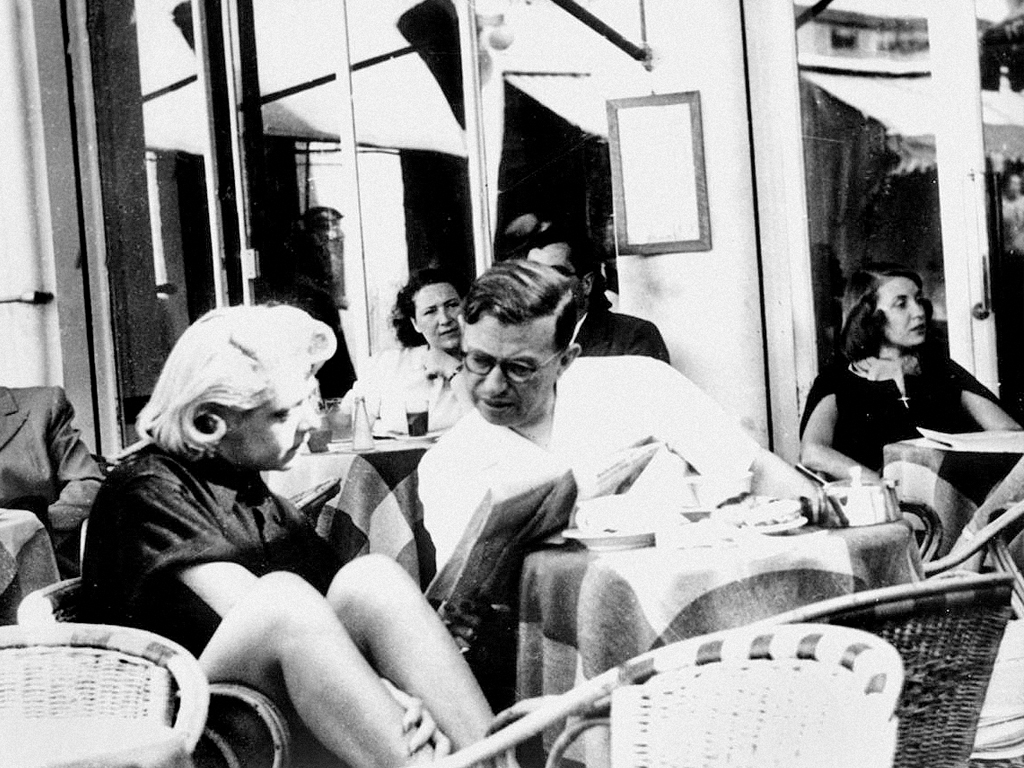
Ottobre 1951
Jean-Paul Sartre seduto al caffè Vuotto insieme ad un’amica
Fine estate del 1951. Dopo aver dedicato gran parte delle sue energie a un saggio su Jean Genet, Sartre parte per un viaggio in Italia. «Con le mani in tasca e della carta bianca in valigia» approda a Napoli dove però resta poco, si imbarca invece alla volta di Capri. Non è il suo primo incontro con l’isola, c’era già stato con Simone De Beauvoir. «Isola di Tiberio, isola romana, isola romantica, isola africana, isola pederastica e simbolista, isola futurista e fascista, isola greca e classica.
Si pensa all’Africa e si guarda a quest’isola così schiettamente mediterranea i cui colori spesso sono quelli delle Alpi Marittime sopra Nizza. C’è uno sfasamento…» scriverà su quei fogli bianchi che saranno poi pubblicati postumi dalla figlia Arlette Elkaïm con il titolo La regina Albemarle o l’ultimo turista.
Passeggia, legge il romanzo di Félicien Marceau Capri petite île acquistato sull’isola, si incontra con Edwin Cerio che definisce “amabilissimo” e che di lui scriverà in un articolo pubblicato su Il Mattino del 22 ottobre 1951. «La prima impressione che mi ha fatto entrando nel mio studio è stata quella d’aver lasciato la celebrità fuori – come si lasciano, nell’anticamera, le galosce o l’impermeabile. Fa una profonda impressione trovarsi di fronte a un uomo famoso liberato dall’ingombrante parafernale della fama».
Gli fa eco sulle pagine de L’Europeo una giovanissima Oriana Fallaci. «A Capri è di moda ignorare certe celebrità che sdrucciolano sull’indifferenza della gente come sulle bucce di banane. Qualche sguardo in più se l’è preso soltanto Sartre, scontroso e bruttissimo, che ha attraversato in fretta la piazza, quasi si vergognasse di farsi vedere, per andare a far visita a Cerio. Il papa di Capri, per non smentire le abitudini dei suoi compaesani, lo ha accolto con cordialità ma fingendo di ignorare chi era».
E quando Antonio Spinosa, all’epoca direttore de Il Roma, viene a sapere che sull’isola, dove non era mai stato, c’è Sartre, la raggiunge più presto che può. «Sartre è seduto davanti a un bar» racconterà. «Mi avvicino senza perder tempo ma lui mi dice, tra francese ed italiano, che non può fare alcuna intervista; ha i minuti contati, deve prendere d’urgenza l’aliscafo e rientrare in Francia». Ci resta male Spinosa, ma in quello stesso momento vede Roger Peyrefitte attraversare la Piazzetta. Sarà lui che intervisterà e da allora Antonio Spinosa tornerà a Capri ogni successiva estate della sua vita.
Jean-Paul Sartre sitting with a friend in the caffè Vuotto
It is late summer 1951. Having devoted much of his energies to an essay on Jean Genet, Sartre sets off on a trip to Italy. He arrives in Naples “with my hands in my pockets and blank paper in my suitcase”, but only stays there for a short time before leaving for Capri. It wasn’t his first encounter with the island: he had already been there with Simone De Beauvoir. “Island of Tiberius, Roman island, romantic island, African island, pederastic and symbolist island, futurist and fascist island, Greek and classical island.
You think of Africa and you look at this island so unabashedly Mediterranean, whose colours are often those of the Maritime Alps above Nice. And you feel a sense of bewilderment…” he was to write on those blank pieces of paper which would later be published posthumously by his daughter, Arlette Elkaïm, with the title Queen Albemarle or the Last Tourist. He went for walks, read Félicien Marceau’s novel Capri petite île which he bought on the island, and met Edwin Cerio, whom he described as “very amiable”. Cerio wrote about Sartre in an article published in Il Mattino of 22 October 1951: “The first impression I had as he entered my study was that he had left his fame outside – just as one leaves one’s galoshes or mackintosh in the hall. It makes a deep impression when you find yourself in front of a famous man, free from the cumbersome paraphernalia of fame.” A very young Oriana Fallaci echoed these sentiments on the pages of L’Europeo. “It’s the fashion on Capri to ignore certain celebrities who slip on people’s indifference as though on a banana skin. Only the surly and extremely ugly Sartre drew a few extra glances, as he crossed the piazza quickly, almost as if he were ashamed to be seen, on his way to visit Cerio.
The father of Capri, not wishing to go against the habits of his fellow islanders, greeted him cordially while pretending not to know who he was.” And when Antonio Spinosa, the editor of Il Roma newspaper at the time, heard that Sartre was on Capri, a place he had never been to himself, he set off there as soon as he could. “Sartre was sitting outside a bar,” he reported. “I lost no time in going up to him but he told me in a mixture of French and Italian, that he couldn’t do any interviews as he was short of time, because he was in a hurry to catch the hydrofoil back to France.” Spinosa felt rather hurt, but at that moment he saw Roger Peyrefitte crossing the Piazzetta and decided to interview him instead. From that time on Antonio Spinosa went back to Capri every summer for the rest of his life.





